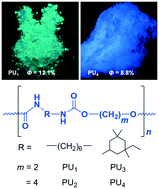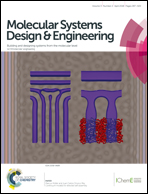Synthesis, clustering-triggered emission, explosive detection and cell imaging of nonaromatic polyurethanes†
Abstract
Nonconventional luminogens without remarkable conjugation have attracted significant attention due to their scientific and technical importance. Their emission mechanism, however, is still under debate. Recently, we proposed the clustering-triggered emission (CTE) mechanism, namely the clustering of nonconventional chromophores and subsequent electron cloud overlap (delocalization) together with simultaneous conformation rigidification, to rationalize the emission. To further check it, nonaromatic polyurethanes (PUs) bearing carbamate (NHCOO) groups were designed and synthesized. While being virtually nonemissive in dilute PU/DMF solutions, PUs are found to be highly emissive when concentrated or aggregated as powders and films. Furthermore, room-temperature phosphorescence (RTP) is detected from the solid powders and films. Clustering of NHCOO groups and electronic communications among carbonyl (C![[double bond, length as m-dash]](https://www.rsc.org/images/entities/char_e001.gif) O) units, N and O atoms are accountable for the emission. Such stereoelectronic interactions were also corroborated by the liquid IR (LIR) measurement. In addition, the aggregates of PUs are also useful for explosive detection and cell imaging.
O) units, N and O atoms are accountable for the emission. Such stereoelectronic interactions were also corroborated by the liquid IR (LIR) measurement. In addition, the aggregates of PUs are also useful for explosive detection and cell imaging.



 Please wait while we load your content...
Please wait while we load your content...